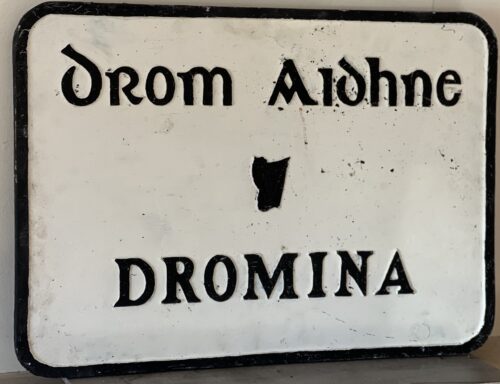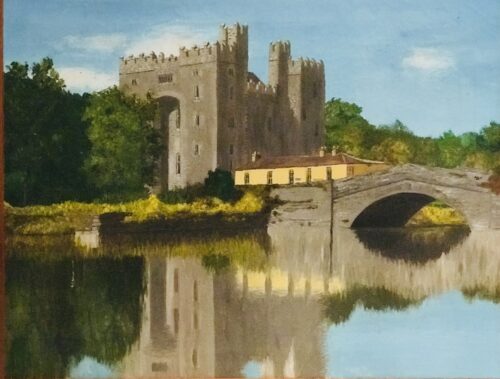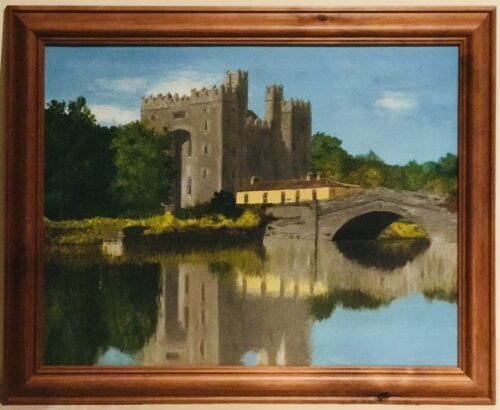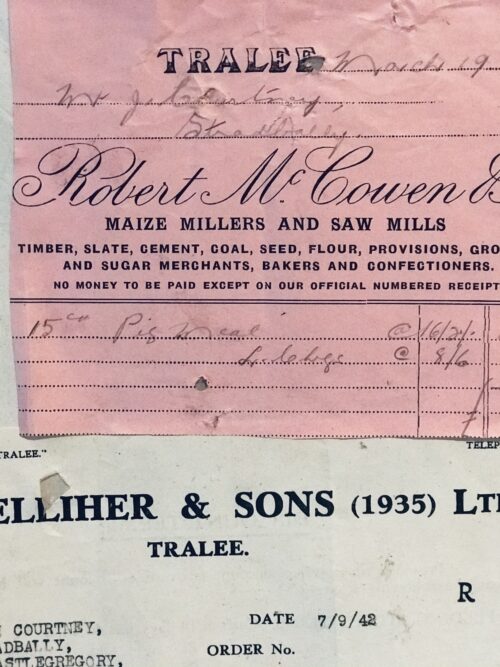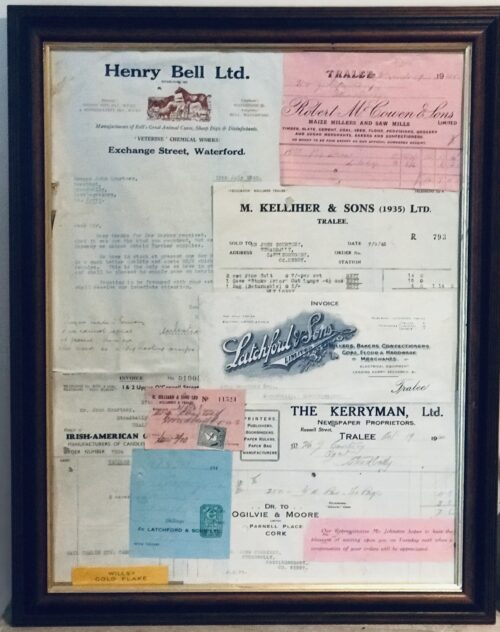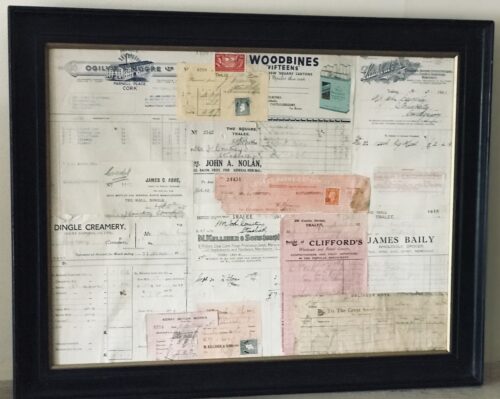Original oil on canvas painting of Bunratty Castle.
45cm x 55cm Limerick
Bunratty -Caisleán Bhun Raithe, meaning "Castle at the Mouth of the Ratty") is a large 15th-century
tower house in
County Clare,
Ireland. It is located in the centre of
Bunratty village (
Irish:
Bun Ráite), by the
N18 road between
Limerick and
Ennis, near
Shannon Town and its
airport. The castle and the adjoining folk park are run by Shannon Heritage as a major tourist attraction
The name Bunratty,
Bun Raite (or possibly,
Bun na Raite) in Irish, means "river basin" of the 'Ratty'
river.
This river, alongside the castle, flows into the nearby
Shannon estuary.

Bunratty Castle Plaque in English
The first recorded settlement at the site may have been a
Norsemen settlement/trading camp reported in the
Annals of the Four Masters to have been destroyed by
Brian Boru in 977. According to local tradition, such a camp was located on a rise south-west of the current castle. However, since no actual remains of this settlement have yet been found, its exact location is unknown and its existence is not proven.
Around 1250, King
Henry III of England granted the
cantred or district of Tradraighe (or Tradree) to Robert De Muscegros, who in 1251 cut down around 200 trees in the King's wood at
Cratloe. These may have been used to construct a
motte and bailey castle, which would have been the first castle at Bunratty, but again the exact position of this is unknown. A later reference in the state papers, dating to 1253 gives de Muscegros the right to hold markets and an annual fair at Bunratty. It has thus been assumed that the site was the centre of early Norman control in south-eastern Clare. Early 19th-century scholars put the structure to the north-west of the current castle. However, when a hotel was constructed there in 1959,
John Huntexcavated the area and thought the remains to be that of a gun emplacement from the
Confederate Wars (see below).

South
solar in Bunratty Castle
These lands were later handed back to (or taken back by) King Henry III and granted to Thomas
De Clare, a descendant of
Strongbow in 1276. De Clare built the first stone structure on the site (the second castle). This castle was occupied from 1278 to 1318 and consisted of a large single stone tower with lime white walls. It stood close to the river, on or near the site of the present Bunratty Castle. In the late 13th century, Bunratty had about 1,000 inhabitants. The castle was attacked several times by the
O'Briens (or O'Brians) and their allies. In 1284, while De Clare was away in England, the site was captured and destroyed. On his return, in 1287, De Clare had the site rebuilt and a 140-yard (130 m) long fosse built around it. The castle was again attacked but it did not fall until 1318. In that year a
major battle was fought at Dysert O'Dea as part of the
Irish Bruce Wars, in which both Thomas De Clare and his son
Richard were killed. Lady De Clare, on learning this, fled from Bunratty to Limerick after burning castle and town. The De Clare family never returned to the area and the remains of the castle eventually collapsed. As the stones were likely used for other local construction works, no traces remain of this second castle
In the 14th century, Limerick was an important port for the English Crown. To guard access via the Shannon estuary against attacks from the Irish, the site was once again occupied. In 1353, Sir
Thomas de Rokeby led an English army to conquer the MacNamaras and
MacCarthys. A new castle (the third) was built at Bunratty, but once again, its exact location is unknown. Local tradition holds that it stood at the site where the Bunratty Castle Hotel was later constructed. However, the new structure was hardly finished before being captured by the Irish. Documents show that in 1355, King
Edward III of England released Thomas Fitzjohn Fitzmaurice from prison in Limerick. He had been charged with letting the castle fall into the hands of Murtough O’Brien whilst serving as a Governor (Captain) of Bunratty.
The fourth castle, the present structure, was built by the
MacNamara family after around 1425. Its builder may have been one Maccon Sioda MacNamara, chieftain of Clann Cuilein (i.e. the MacNamaras). He died before the castle was completed which happened under his son Sean Finn (died in 1467). At around 1500, Bunratty Castle came into the hands of the O'Briens (or O'Brians), the most powerful clan in
Munster and later Earls of Thomond. They expanded the site and eventually made it their chief seat, moving it there from Ennis.
In 1558, the castle—now noted as one of the principal strongholds of
Thomond—was taken by
Thomas Radclyffe, the
Lord-Lieutenant of Ireland from Donal O'Brien of Duagh, last King of Thomond (died 1579), and given to Donal's nephew,
Connor O'Brien.
Donogh O'Brien, Conor's son, may have been the one to move the seat of the family from Clonroad (Ennis) to Bunratty. He made various improvements to the castle including putting a new lead roof on it.
During the
Confederate Wars set off by the
Irish Rebellion of 1641,
Lord Forbes, commanding forces of the English
Long Parliament, was allowed by the then Lord
Barnabas O'Brien to occupy Bunratty in 1646. Barnabas did not want to commit to either side in the struggle, playing off royalists, rebels and
roundheads against each other. He left for England, where he joined King
Charles. Defence of the castle, whose position allowed those holding it to blockade maritime access to Limerick (held by the
Confederates) and the river Shannon, was in the hands of
Rear-Admiral Penn, the father of
William Penn, founder of Pennsylvania. After a long siege, the Confederates took the castle. Penn surrendered but was allowed to sail away to
Kinsale.
Barnabas O'Brien died in 1657, but had apparently leased out the castle to one "John Cooper", possibly the same person married to Máire ní Mahon of
Leamaneh Castle, widow of another O'Brien, Conor (died 1651).
Bunratty Castle remained property of the O'Briens and in the 1680s the castle was still the principal seat of the Earls of Thomond. In 1712, Henry, the 8th and last
Earl of Thomond (1688–1741) sold Bunratty Castle and 472 acres (191 ha) of land to Thomas Amory for £225 and an annual rent of £120. Amory in turn sold the castle to Thomas Studdert who moved in ca. 1720.
The Studdert family left the castle (allowing it to fall into disrepair), to reside in the more comfortable and modern adjacent "Bunratty House" they had built in 1804.
The reasons for the move are bound up in family arguments over the eldest son marrying his first cousin.
For some time in the mid-19th century, the castle was used as a barracks by the
Royal Irish Constabulary.
In 1894, Bunratty was once again used by the Studdert family, as the seat of Captain Richard Studdert.
In the late 19th century, the roof of the Great Hall collapsed.
In 1956, the castle was purchased and restored by the 7th
Viscount Gort, with assistance from the
Office of Public Works.
He reroofed the castle and saved it from ruin. The castle was opened to the public in 1960, sporting furniture, tapestries and works of art dating to around 1600.

Rose Cottage at the Folk Park
Today, the castle is a major tourist attraction, along with "Bunratty Folk Park". Both the castle and Bunratty House are open to the public. The castle is famous for its medieval banquets, offered since 1963, at which the "Bunratty Castle Entertainers" perform today. "Bunratty Folk Park" is an open-air museum featuring around 30 buildings, including the
Ardcroney Church Of Ireland church, which moved here and reopened in 1998.
Recently and controversially the Armada table of the O’Briens, princes of Thomond, was sold at auction for the princely sum of €360,000. Made from the timbers of a ship from the Spanish Armada which was wrecked off the coast of Co Clare in 1588 it had been placed for sale with Adam’s auction house yesterday, guiding between €100,000 and €200,000. In the end it sold to an undisclosed Irish buyer for €360,000.
“The good news is, it will be staying in Ireland, ” says the managing director of Adam’s auction house, James O’Halloran. “That’s all we’ve been allowed to say for the moment, but we’re hoping that more information will be released fairly soon.” It’s understood that the State was outbid for the table and that the new owner is a private buyer.
Bidding on the table started at €70,000 but with one online bidder, three on the phone and one person in the room, it didn’t take long to sail past its lowest guide of €100,000, followed quickly by its top estimate of €200,000. “It got to €360,000 quite quickly,” O’Halloran says. “We thought it would do reasonably well, but because there was nothing to compare it to, we didn’t really know what to expect.”
The three-metre-long table was the property of Lord Inchiquin. Its rectangular top sits on a frieze of a dozen carved heads, with four carved heraldic lion corner supports and two figures of Hope and Charity, which would originally have been found on the stern of a galleon. It spent 300 years at Dromoland Castle before moving to Bunratty, where its elaborate series of carved masks became a key attraction.
When it was announced that the table – described by the Knight of Glin, Desmond FitzGerald, as “one of the most important and earliest pieces of Irish furniture” – was to be sold at Adam’s Country House Collections sale at Townley Hall, near Drogheda, Co Louth, there were calls for it to be kept in Ireland as it represents part of our cultural heritage. The only question now is, where will the table find its new home?
Origins :Co Limerick
Dimensions :30cm x 36cm











































































 62cm x 45cm
An absolute once off piece of Irish Memorabilia .We at the Irish Pub Emporium were so lucky to acquire from a private collector .These superb castiron road signs were commissioned by the Irish Free State in the late 1940s post and were initially the responsibility of the newly formed Irish Tourism Organisation -Fógra Failte (later to become Bord Failte and then Failte Ireland).
"The former '
62cm x 45cm
An absolute once off piece of Irish Memorabilia .We at the Irish Pub Emporium were so lucky to acquire from a private collector .These superb castiron road signs were commissioned by the Irish Free State in the late 1940s post and were initially the responsibility of the newly formed Irish Tourism Organisation -Fógra Failte (later to become Bord Failte and then Failte Ireland).
"The former '


